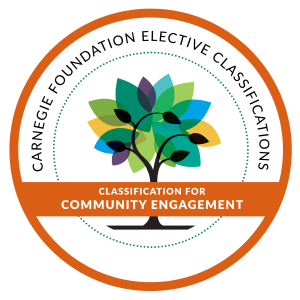Category: Uncategorized
Carnegie Community Engagement Classification
The office of Experiential Learning team lead Penn State University’s application and institutional self-study for the Carnegie Community Engagement Elective Classification, chaired by Michael Zeman, Director of Experiential Learning, leading a task force that included a core strategy team, with designations achieved in 2008, and most recently 2015. Engaging with over 250 voices across all campuses and many community partners, the task force collected data, critically reflected, engaged in dialogue, and implemented the institutional self-assessment to document and enhance community engagement at Penn State University.
As a modern land-grant institution, Penn State remains deeply committed to fostering meaningful relationships with communities across Pennsylvania and beyond. The 2026 Carnegie Community Engagement (CE) Reclassification application offered a critical opportunity to reflect on and elevate that commitment—highlighting how our institution integrates engagement across teaching, research, outreach, and service.
Through the 2026 application process, Penn State has reaffirmed its commitment to building trust, leveraging collective assets, and co-creating solutions that benefit all. This reclassification is not simply a designation—it is an invitation to further align our institutional mission with the evolving needs of society.
The Carnegie Foundation’s Community Engagement Classification is a prestigious national recognition that highlights Penn State’s commitment to meaningful partnerships with our communities through teaching, research, and service. This classification underscores how our engagement efforts enrich student learning, advance scholarship, and address societal challenges in mutually beneficial ways.
What is Community Engagement?
The reclassification process affirmed Penn State’s evolving definition of community engagement—one that prioritizes reciprocity, co-created solutions, and long-term impact. This institutional reflection also underscored the strategic role of community engagement in addressing pressing societal challenges through public impact research while supporting student learning and professional development.
Unlike many institutions that view community engagement as a campus-to-community effort, Penn State approaches it as a University-to-Commonwealth commitment, reflecting its unique structure. With 23 Commonwealth campuses across urban, suburban, and rural areas, Penn State delivers statewide educational access and engagement, fulfilling its land-grant mission through deep, mutual local partnerships.


Based on Penn State’s 2025 Strategic Plan, particularly the goals of Enhancing Student Success and Increasing Land-Grant Impact, below are three significant ways the University can strengthen its community engagement efforts.
Integrate Community-Engaged Learning Across the Curriculum
To enhance student success, Penn State can expand opportunities for undergraduate and graduate students to participate in community-engaged learning experiences that are embedded within their academic programs. This includes creating specific program learning outcomes (PLOs) for community engagement, service-learning courses, community-based and broader-impact-based research projects, and internships with local organizations. Such experiences not only enrich student learning but also foster civic responsibility and real-world problem-solving skills. By aligning these opportunities with community needs, the University can ensure that student learning contributes meaningfully to societal challenges, thereby fulfilling its land-grant mission.
Enhance Coordination Among Commonwealth Campuses, Outreach, and the geography of Pennsylvania
Penn State’s extensive network of Commonwealth Campuses, extension offices, and engagement officers positions the University uniquely to serve diverse communities across the state. To maximize this potential, the University can improve coordination among these entities to share best practices, resources, and strategies for community engagement. This collaborative approach can lead to more cohesive and impactful programs that address local economic development, workforce training, and public health initiatives, thereby amplifying the University’s land-grant impact.
Develop a Centralized Infrastructure for Tracking and Supporting Community Engagement Activities
To effectively measure and enhance community engagement, Penn State can establish a centralized system to document and assess community engagement activities across all campuses and units. This infrastructure would facilitate the sharing of information, enable the evaluation of impact (e.g., create and implement standard SLOs of HIPs metrics), and identify areas for improvement. By systematically tracking (community) engagement efforts, the University can ensure alignment with strategic goals, recognize and support faculty and staff contributions, and demonstrate accountability to community partners.
